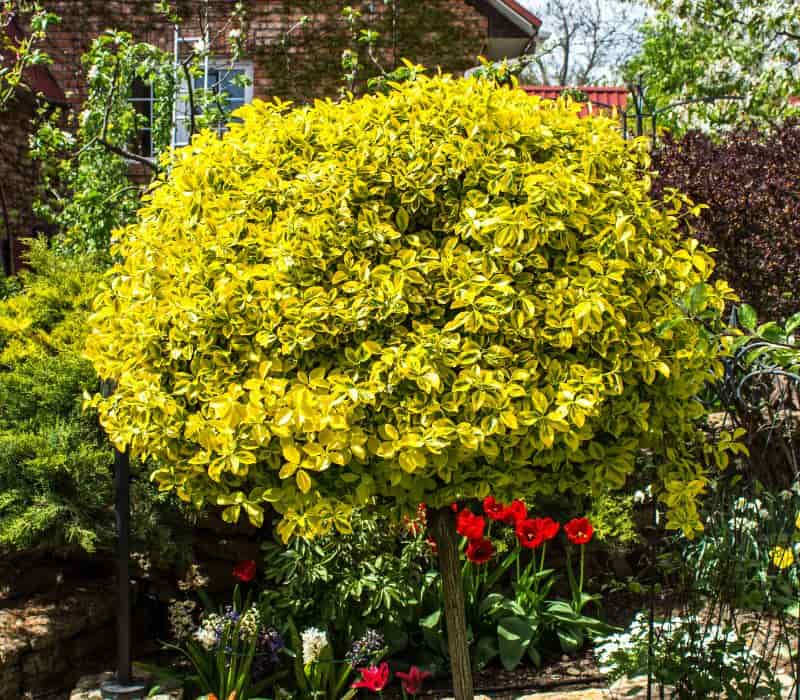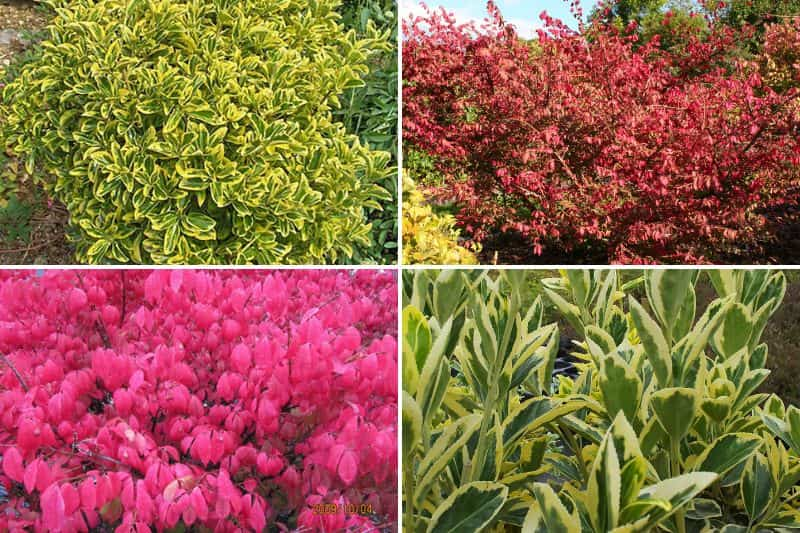Highly decorative, spindle (Euonymus) has all the qualities to charm most gardeners. It is hardy, resistant to air pollution, undemanding regarding soil or aspect... With a bushy, climbing or spreading habit depending on variety, and leaves deciduous or evergreen, leathery and glossy, it adapts to every situation. It can be planted as a specimen, in a mixed border or a clipped edge, just as it can form part of a free-standing or formal hedge. In recent years, it has also become an alternative to box, which has been largely ravaged by box moth. Not forgetting pot and container culture on a balcony or terrace, which suits it perfectly. With more than 175 species from all corners of the globe, spindle is also notable for a wide palette of differently coloured foliage. In short, it is a highly adaptable bush that can make a perfect subject when trained on a stem.
We explain step by step how to train spindle as a standard and how to maintain it so it keeps that distinctive form.
What is a spindle trained as a standard?
Practically speaking, a bush trained as a standard has a straight, regular trunk, like a long naked stem, bearing at its top a neat ball of dense, compact foliage. Depending on species and varieties trained as standards, branches may flower, or sometimes be pendulous or gracefully spreading.
Generally, a bush trained as a standard reaches 1 to 1.5 m in height and is grown in a pot. It is a particularly ornamental bush, full of grace, elegance and finesse.
Thanks to its many species with different habits and coloured foliage, spindle lends itself well to being trained as a standard and adapts very well to this type of plant creation. A spindle trained as a standard is particularly suited to a small urban garden, where it will become the focal point by giving the illusion of a tree. It can also easily find a place on a terrace or balcony when grown in a pot.

Which varieties to choose to create a spindle trained as a standard?
To obtain a spindle trained as a standard, favour varieties with an erect, upright habit, as creeping varieties are poorly suited. You should choose a variety with a strong, central branch, well vertical, which over the years will form the trunk of the standard.
Preferably also select an evergreen spindle that will remain attractive all year round. But a deciduous foliage with flamboyant autumn colours can also be very charming.
We recommend:
- Euonymus japonicus ‘Aureus’: with a very compact habit and dense, evergreen foliage in cream-yellow marginate with green, particularly decorative. Especially suited to topiary, it tolerates pruning very well. It also has a naturally bushy, upright habit. At maturity it can reach 1.50 to 2 m high for 1 m spread, though pruning will reduce its dimensions
- Euonymus japonicus ‘Aureomarginatus’: fairly close to the previous one, this Japanese spindle variety also has bright foliage, dark green marginate with golden yellow. It is therefore very decorative, including in winter since its foliage is evergreen. With a bushy, naturally erect habit, it is also very ramified
- Euonymus alatus (or winged spindle): although its foliage is deciduous (yet it often remains on branches until December), this winged spindle has every quality to be formed as a standard. First, its foliage is extraordinary: tender green in spring, turning crimson-purple in autumn and appearing even brighter thanks to very decorative lantern-shaped fruits in deep magenta. In terms of size, at maturity it is limited to 2 m in every direction
- Euonymus alatus ‘Compactus’: like the species, this spindle is remarkable for foliage that adopts an extraordinary autumn wardrobe. Leaves turn a fiery red before shifting to purple, then pinkish before falling in December. This foliage is further highlighted by the presence of pink and orange berries. However, it only reaches 1 m in every direction, making it an ideal subject for pot culture as a standard.
- Euonymus japonicus ‘Bravo’: a Japanese spindle with variegated foliage of green and cream-white. Well suited to container culture, it has a bushy, naturally rounded and compact habit. It averages 2 m high for 1.50 m wide.
Overall, all Japanese spindles are suited to being trained as standards. By contrast, Euonymus fortunei are less so, as they tend to have a creeping habit.

When to carry out training as a standard?
The ideal period to train your spindle as a standard is before sap restart, in February–March. Training can be continued until the end of summer.
Step-by-step formation of a spindle trained as a standard
Training a spindle as a standard takes two to three years. This formation can be carried out on a bush planted in the ground or in a pot. In the ground it needs neutral, rich, cool soil that is above all well drained. In a pot, provide a substrate made of equal parts garden soil, compost and coarse sand, and do not forget clay balls as a draining base.
Staking
This is the first step in training a spindle as a standard. Staking allows the selected stem to grow perfectly straight and vertical to form the trunk.
- Select a stake about 2 m high since it must be taller than the final height of the stem
- Drive it gently into the substrate about 10–15 cm from the base
- Select the most vigorous shoot to be staked upright
- Tie this shoot to the stake with soft ties every 5 cm or so, without tightening so as to allow sap to circulate. Likewise, ties must not wound the shoot while keeping it upright
- Remove other branches arising from the base so only a single stem remains
Regular pruning
Spindle will normally produce young shoots and suckers at the base. The aim is to regularly remove these shoots so sap rises only in the main stem.
- Cut all lateral shoots appearing on the new small trunk. They should be removed when they reach about 10 cm in length
- Also remove suckers by cutting them at the base of the stem
- Do not touch the central stem which will produce leaves
Each year, remove new shoots that appeared during summer and retain only the selected central stem. The small trunk forms gradually, as does the upper part which must not be touched.
On this central stem, keep only the four to five largest branches which, together with the leading shoot, will form the head of the spindle. These branches must be pruned regularly by shortening them by half each year. When your spindle has reached its final size, you may also prune the main branch.
After 2–3 years, your spindle will present a compact, dense tuft atop a straight stem. You can remove stake and ties.
Maintenance
During this period of forming as a standard, spindle requires particular attention:
- Water regularly to keep soil fresh, about once or twice a week during growth. Prefer rainwater for watering
- Fertilise regularly with a liquid feed during the growth period
- Continue to remove young lateral shoots and suckers
- In regions with rather harsh winters, overwinter your spindle trained as a standard if grown in a pot. Japanese spindles are somewhat more tender than other spindles. Moreover, a bush trained as a standard is a little more sensitive to cold.
After 3–4 years, your spindle trained as a standard will be robust enough to be repotted into a larger pot. Of course renew the substrate and choose a heavy, stable pot to support the spindle, which is more exposed to wind due to its shape.
Essential equipment for training as a standard
- Pruning shear sharp and above all perfectly cleaned and disinfected to avoid spreading disease
- A stake strong enough and weather-resistant, in bamboo, stainless steel or PVC
- Soft ties or collars for staking.































![[plant_guide title="How to Train a Standard Euonymus"]
To train a standard {glossary}Euonymus{/glossary}, follow these steps:
1. Choose a young plant with a straight stem.
2. Remove any side shoots up to the desired height of the crown.
3. Tie the stem to a stake for support.
4. Prune the top growth to encourage branching.
5. Continue to prune regularly to maintain the desired shape.
By following these steps, you can successfully train a standard {glossary}Euonymus{/glossary} on a stem. Euonymus alatus as a tree](https://en.promessedefleurs.eu/blogwp/wp-content/uploads/2023/03/Comment-former-un-fusain-sur-tige-.png)
Comments